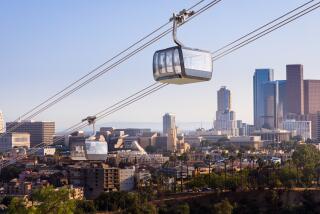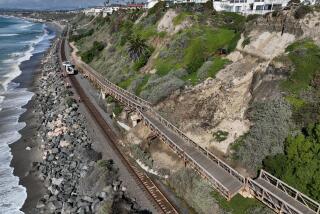Editorial: Is the proposed Port of L.A. rail yard an environmental bait and switch?
After more than 10 years of analysis, a 5,000-page environmental impact report, countless public hearings and seven lawsuits, a judge last week blocked plans to build a new rail yard at the Port of Los Angeles. The new yard, to be known as the Southern California International Gateway, was planned as a $500-million, 153-acre freight transfer point where trucks could deliver containers from the nearby docks to trains ready to haul the cargo across the country. It was sold to then-Mayor Antonio Villaraigosa and the Los Angeles City Council as the greenest facility of its kind in the U.S., one that would significantly improve traffic and air quality by eliminating more than a million truck trips each year to the existing rail yard 24 miles away.
But an L.A. County Superior Court judge last week put the project on hold, ruling that the Port of L.A. and BNSF Railway overstated its environmental benefits and underestimated its effect on noise, truck traffic and greenhouse gas emissions. In particular, the judge took issue with one of the project’s main purported benefits — that it would eliminate the need for long truck trips to BNSF’s existing rail yard near Commerce. In fact, the judge said, it appeared that the new yard would supplement, not replace, the old yard, essentially doubling BNSF’s capacity to move cargo to and from the port.
This page supported the SCIG project in 2013 because the 5,000-page EIR and port officials made a compelling case that the environmental and economic benefits were greater with the project than without. There is no question that the rail yard makes good business sense — international trade is a major economic engine for the region and projects that move freight more efficiently help bring in more business and create more jobs. But the judge’s ruling, which poked holes in many of the assertions made by supporters, should give L.A. leaders pause. Before Mayor Eric Garcetti and the general manager of the port, Gene Seroka, double down on the project and file an appeal, they should seriously consider whether there is a better way to build the SCIG.
This is the right time to reevaluate. Last year, Gov. Jerry Brown ordered up a Sustainable Freight Action Plan that will lay out how quickly California can transition to zero-emission equipment. The draft plan should be released this month. When Congress finally adopted a transportation bill last fall, members included nearly $11 billion for freight-related projects, which could help the port invest in projects that move cargo more efficiently with less pollution.
The Port of L.A. is already under scrutiny after officials disclosed that they’d let two major shipping companies skirt requirements to cut dirty diesel pollution from their operations. The court ruling raises concerns that city and harbor officials are again cutting corners on environmental issues and public health.
Follow the Opinion section on Twitter @latimesopinion and Facebook
More to Read
A cure for the common opinion
Get thought-provoking perspectives with our weekly newsletter.
You may occasionally receive promotional content from the Los Angeles Times.






